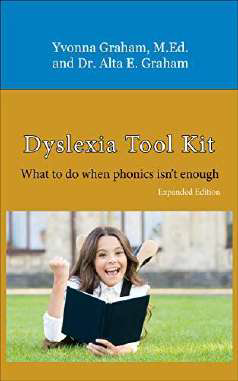
“Audio books, turned out to be the most powerful tool I had in my toolkit.” – Yvonna Graham, MEd., author Dyslexia Toolkit
Despite the widespread availability of text-to-speech and audiobooks, it’s only a small percentage of people who discover and use these tools.
Parents and teachers may feel ambivalent about the use of audiobooks, especially if they believe that students need to practice reading, but the downside of withholding audiobooks or assistive technology in general is that they may deny individuals a tool that could really accelerate their reading progress.
Recently, I sat down with author and dyslexia tutor Yvonna Graham to learn how she uses audiobooks and how they can accelerate reading progress rather than hamper it.
Audiobooks are not a replacement for structured literacy instruction when children or adults struggle with basic decoding – that is necessary. But if you want to get someone hooked on reading for pleasure as well as help catch them up with the learning through books that their classrooms demand, audiobooks may be a rocket pack for learning.
Yvonna:
 “The pushback that you’ve seen, and I’ve seen across the board from lots and lots of educators is that they feel like if kids listen to audiobooks, they won’t put in the effort to read. What I found in actual practice, and what you actually showed research for in that first edition of Dyslexic Advantage is that the opposite happens. If the child is allowed to use audiobooks, to up their game, as far as their understanding of literature and syntax, then that student is more motivated to learn to read. They put in more effort. And in fact, comprehension improves dramatically. So just an audio book is a great tool.
“The pushback that you’ve seen, and I’ve seen across the board from lots and lots of educators is that they feel like if kids listen to audiobooks, they won’t put in the effort to read. What I found in actual practice, and what you actually showed research for in that first edition of Dyslexic Advantage is that the opposite happens. If the child is allowed to use audiobooks, to up their game, as far as their understanding of literature and syntax, then that student is more motivated to learn to read. They put in more effort. And in fact, comprehension improves dramatically. So just an audio book is a great tool.
What I found is that real progress happens if you pair audiobooks with tracking, so you have a student listening and looking at the text at the same time, without trying to do multiple things at once. Tracking with an audiobook means students don’t have to vocalize words, sound out words, and all of that. If they’re just watching the words, and they’re hearing the words, this amazing thing happens. I tell the kids, the words are going to go in your ears and your eyes at the same time, and they’re going get locked in your brain. That’s a simple way of saying dual processing, which is what Dr. Matthew Schneps talks about in his research. His ongoing research, which I know you’ve been following, is a powerful resource. I’ve used it with hundreds of students with dyslexia, with tremendous success.”
RESOURCES FOR AUDIOBOOKS
One of the best sources for free audiobooks is your local library. Check out a print book and an audiobook to listen while reading along.
Readings by professional actors tend to be easier to listen to than electronic voices, but the gap between these two seem to be narrowing.
Here is a video for downloading an audiobook from Libby a public library app:
In the video below, see how you can take a picture of text with an iPad and the Voice Dream Reader app, then have it read aloud to you with each word highlighted as it is read.
US students with dyslexia / ‘print disability” are eligible for FREE e-books through Bookshare. If you don’t have someone who can certify your print disability, the online Neurolearning app may be able to qualify you for free (US students) or discounted (adult readers) e-books.














